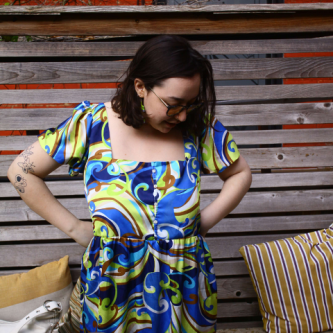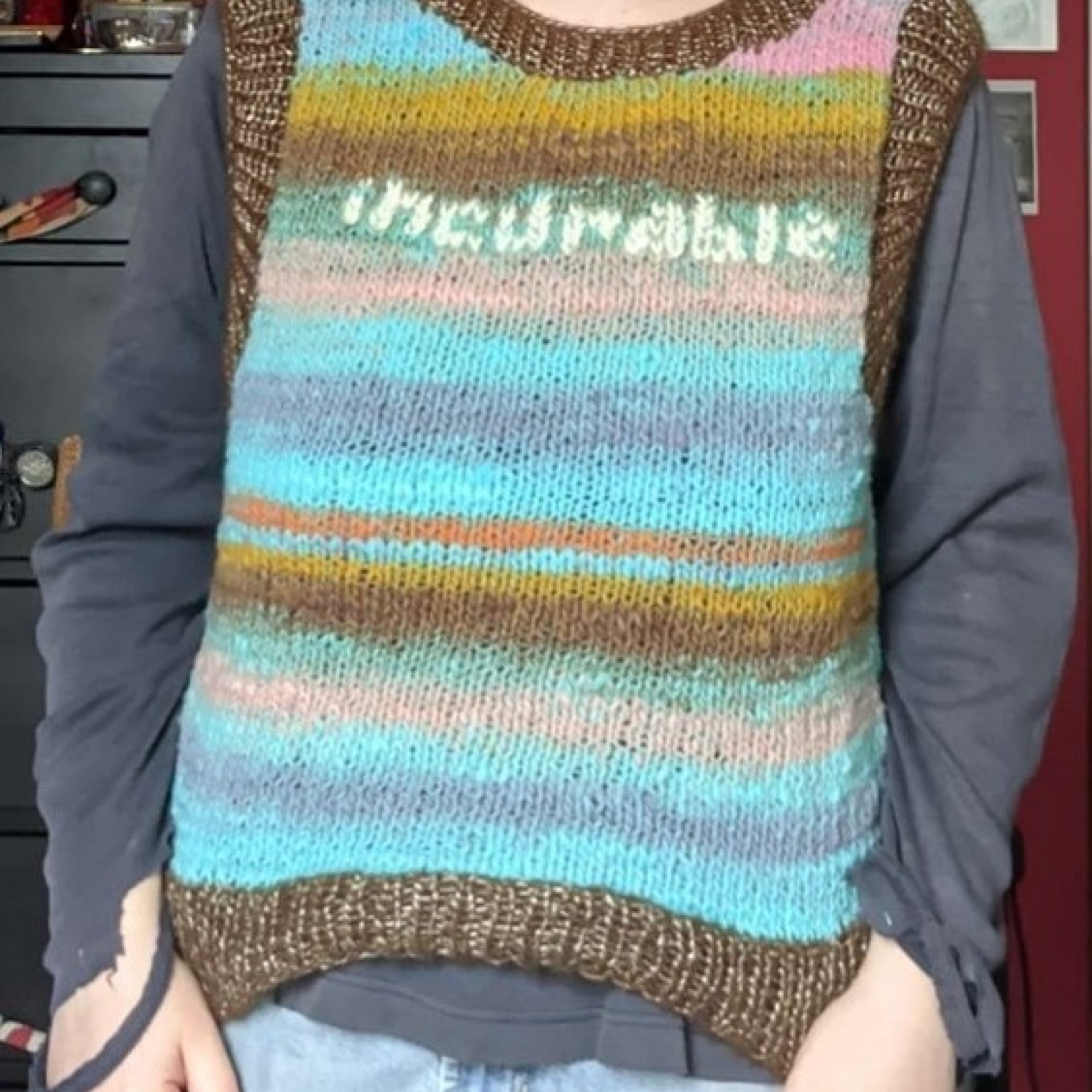Incurable Vest is a hand-knit vest featuring two stanzas of a poem I wrote challenging ideologies of cure and the supposed inherent inferiority of disabled people, given the supposedly immutable fact that we do not have some of the abilities our society is obsessed with (Fixed: The Science/Fiction of Human Enhancement). One stanza of the poem is meant to be on the front of the vest, and the other on the back, making the poem reversible based on which side the viewer sees first.
The poem reads as follows:
“sometimes despite
sometimes because
often regardless
always including
incurable
i like me this way”
Multiplicity, the ability to be multiple things at once, some of which may even be in conflict with each other, is denied to disabled people, as we are supposed to all experience disability statically and the same way: our present lives must be unlivable, therefore making a future without us a self-evident, desirable outcome (Kafer 2), and making cure a necessity. Expanding my understanding of the ideology of cure has been a long-overdue reckoning. Eli Clare, disability scholar, writer, artist, and author of Brilliant Imperfection: Grappling with Cure, helped me understand the spectrum within cure, comprising of what needs to be discarded, what we might need, what saves lives, and all the complexities in between. Their work, and the work of many other writers, scholars, and theorists, such as AJ Withers and Leah Lakshmi Piepzna-Samarasinha, who help me name and hold the experiences and inherent multiplicities unique to disabled life, affords me the opportunity to stand tall in being disabled and loving myself and others without being, or aspiring to be, cured. Embodying these things, and bringing them into being beyond just my mind, became important to me.
I knew I wanted to make art not only about their work but building on it. I also knew I needed my work to be seen by an audience wider than just myself; by a diverse public, who do not regularly think of disabled people, much less thinking of us outside of being pitiable or in charity supercrip terms. This is important because to be disabled for me is a life inseparable from politics: for example, making the choice to kill or not to kill pain with drugs (prescribed or not) is a political one. It is also a rather isolating life because few people can understand the daily realities of my life, so sharing this work with a wide audience has the potential for myself and other disabled people to be knowable to those who do not (yet) share our experiences. This vest allows me to claim disability, to choose it and not just be relinquished over to it, especially as someone who is not usually visibly disabled. Given that the very definition of disability is “in constant flux and appearing different depending on the position of the onlooker,” (Withers 7) wearing this vest will problematize the very rigid ableist ideas of what disability looks like, while addressing the endlessly expanding list of what qualifies as a disability.
Life experience shows that disability is not an immutable fact of someone’s life. Much to the contrary, I am disabled in different ways on different days and in different spaces, depending on the severity and in/tolerability of my chronic symptoms, on if and how my access needs in any given space are met.
Making this vest forced me to grapple with the many facets of my own feelings about cure. Knitting and textile art generally act as a form of journaling for me, allowing me to capture and express bits and pieces of what I am feeling at the time. When I finished knitting the vest and it was time to embroider the poem onto it, I found myself not, in fact, “liking me this way.” I could not work on it for a week because of how completely opposed to that statement I felt. I was reminded of the power of saying things to ourselves even when we do not believe in them. “[I] want us to remind each other of our beauty, strength, and resilience; then tape those reminders to our bathroom mirrors […] read them out loud every day, even when we don’t believe them” (Clare 166). This reminder allowed me to begin the embroidering of the vest, starting of course with the most important word in the poem: incurable. I am not sure when I will finish embroidering the vest, as my feelings about cure continue to be challenging, and engaging with them so directly is often out of the realm of my mindbody’s capacity because of all that I navigate daily as a disabled person. Until then, and long after as well, wearing this vest will, on those dark days, remind me of all the times when I do like me this way.
The poem was incorporated into the vest through duplicate stitching, an embroidery technique for textiles knit in the “stockinette stitch” (the conventional, quite simple, and most recognizable knitting stitch) that makes the embroidery appear as if it was simply knitted into the garment, instead of appearing embroidered over top of it. The intention behind centering knitting is to honour the legacy of disability arts within knitting and textile communities, and the role of knitting as an accessible art to outsiders, many of whom are disabled (Warner), as it can be practiced from “the secret bliss of bed.” (Piepzna-Samarasinha 111). I had to create charts to plan out how the words would be inscribed onto the vest, forcing me to grapple with the sort of pixel art graphic design I have no prior experience with.
One often sees people wearing T-shirts leftover from charity events relating to disability, almost exclusively raising money for research into a cure, instead of, say, making more accessible housing (Clare 90). Both these clothes and disabled people themselves are seen as disposable, because neither fit into the mold of what is acceptable or desirable as a worker under capitalism. Leftovers from charity events are relegated to being workout clothes or house-cleaning-wear and the like, which at least makes them useful, a state of being widely denied to disabled people. Hand-knitting and embroidery, each a lengthy, laborious process, challenges these ideas. I want disability-related attire that is centered around the experiences of disabled people, instead of disregarding them entirely in deference to supposed “experts” who have long chosen to further disable us, sterilize us without our consent or even knowledge, and kill us, over any kind of support that is not cure-focused (Withers 34). I want clothing that is accessible, comfortable, soothing, precious, and life-giving for me and other disabled folks. I want to, at least in my clothing, live in a world where I am safe from societal eradication through forced isolation and the myriad other ways ableism oppresses me. I want clothing that is one-of-a-kind, tailored to the needs of its wearer, and for the person who makes it to be valued for their work, unlike the modern slavery of the garment-making industry which allows charity organizations to make as many screen-printed shirts as cheaply as possible. “Here, dressing becomes a practice of crip imagination, connection, and rebellion” (Cripping Masculinity: Designing Fashion Utopias).
In wearing the Incurable Vest in my day-to-day life, I will be literally carrying a manifestation of my crip labour, the labour of keeping myself and my disabled loved ones alive, around on my shoulders, and, for once, making clear that labour from the get-go. I will be carrying my response to eugenic ideas of a better world being one without whoever is currently being categorized or Bell-curved as disabled (Withers 36). I will be carrying crip “dreamtime” (Piepzna-Samarasinha 111), the time I spend dreaming and creating from bed, on my shoulders.
I want disabled people to be acknowledged as inherently valuable including our disabilities. I want our existence, survival, and thriving to be acknowledged as inherently and inevitably generative. I want to, with this vest, tell anyone who looks at me that I am the expert on my own body, that all disabled people are. As Gregor Wolbring, a bioethicist and “ability studies” scholar, says in the documentary Fixed: The Science/Fiction of Human Enhancement, “ableism is our obsession with certain abilities and the accompanying negative treatment of people who don’t have these kinds of abilities.” Why should I be cured of not meeting other people’s standards and obsessions?
Wearing this vest out in the world will be an act of ongoing performance art, as I intend to wear it in my everyday life, in public spaces. I want this vest to look people in the eye just as they stare at disabled people. I need to continue to engage with disability studies, thought, and disability arts, for the sake of my own wellbeing.
In my work for the course Extraordinary Bodies, a disability studies primer taught by the brilliant Loree Erickson, and especially through this project, I have realized that my art has always been in the category of disability arts. When I was a teenager, making colourful entirely non-objective abstract worlds my mad crip self could escape into, to help give myself some sense of relief from all that I was experiencing, I was making disability art. When I use metalwork to make a material manifestation of what I have left of a dear mad friend of mine in the wake of their suicide, I am making disability art. When I value scraps, when I refuse to let these items seen as useless and without purpose or life or possibility be thrown away, just as disabled people are seen and made disposable, I am making disability art. When I carry on the legacy of my ancestors, such as my grandmother, who I in retrospect understand to be disabled, by knitting to clothe myself and my loved ones, to knit as a healing act, I am making disability art. Reading the work of Eli Clare, among authors I mentioned, as well as engaging directly with disability arts, such as watching the film Fixed: The Science/Fiction of Human Enhancement, and visiting Tangled Arts + Disability’s Cripping Masculinity: Designing Fashion Utopias exhibit about creating garments in collaboration with and specifically for masculine-of-center variously disabled people, has allowed me to make more sense of myself and of has given me direction and understanding of myself as a disability artist.

Espie Krementsova
Espie Krementsova (they/them) is a disabled, Jewish, queer and trans artist based in Toronto. Their work focuses on creating spaces and moments of rest, comfort, and safety, if not joy and pleasure, specifically for queer and trans people, particularly for those who are disabled. In a world hellbent on the eradication of these groups, creating crip spaces and trans spaces is imperative. Spaces that center rest on the one hand, and the joy and wonder and pleasure that our bodies, variously disabled throughout our lifetimes, can bring on the other hand. They are a painter, writer, editor, poet, occasional filmmaker and installation artist, and a fiber artist. They can usually be found crocheting Victorian lace and/or ritualizing small daily acts of self-care.
Work Cited
- Clare, Eli. Brilliant Imperfection: Grappling with Cure. Duke University Press, 2017.
- Fixed: The Science/ Fiction of Human Enhancement. Directed by Reagan Brashear, New Day Films, 2013.
- Kafer, Alison. “Imagined Futures; and Debating Feminist Futures: Slippery Slopes, Cultural Anxiety, and the Case of the Deaf Lesbians.” In Feminist, Queer, Crip. Indiana University Press, 2013.
- Lakshmi Piepzna-Samarasinha, Leah. “So Much Time Spent In Bed: A Letter to Gloria Anzaldúa on Chronic Illness, Coatlicue, and Creativity.” In Care Work: Dreaming Disability Justice. Arsenal Pulp Press, 2018.
- Tangled Art + Disability. “Cripping Masculinity: Designing Fashion Utopias.” Accessed April 16, 2023. tangledarts.org/whats-on/cripping-masculinity-designing-fashion-utopias/
- Warner, Natalie B. “Some Thoughts on Knitting and Accessibility.” Natalie in Stitches. Last modified July 19, 2020. natalieinstitches.com/2020/07/19/some-thoughts-on-knitting-and-accessibility/
- Withers, A. J. Disability Politics and Theory. Fernwood Publishing, 2012.
